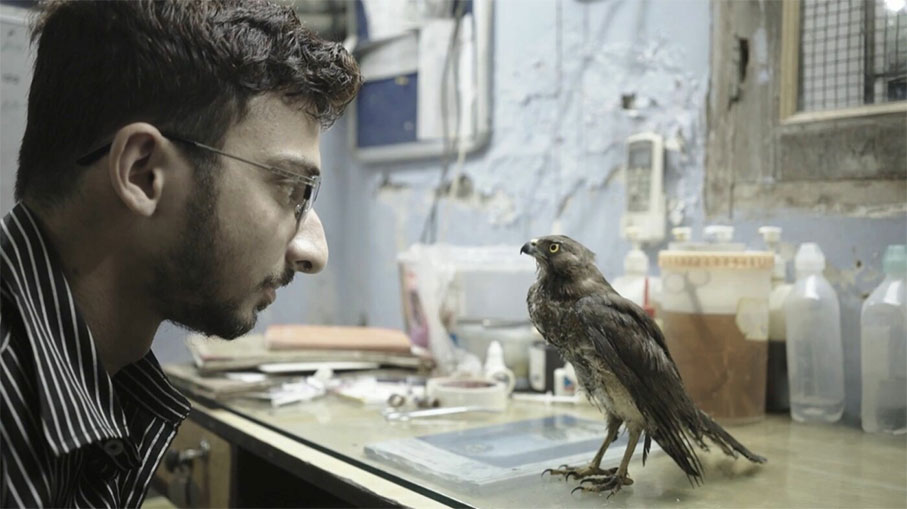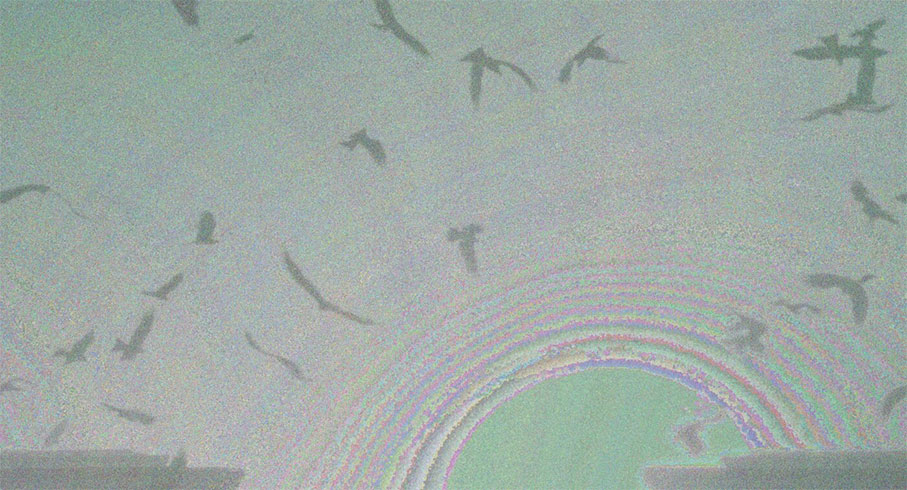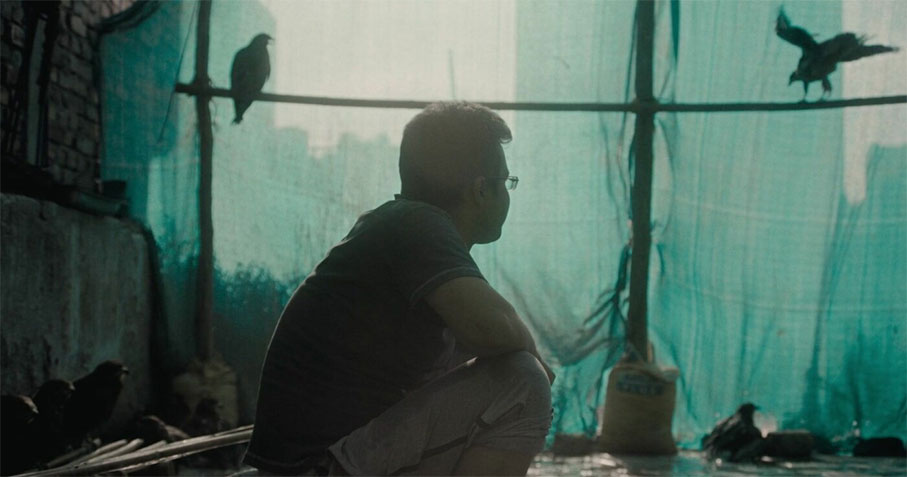|
In Romain Gary’s final novel, The Kites, the titular papier-mâché constructions stand as symbols of Liberty and French resistance to Nazi tyranny. The kites that a quixotic village postman creates, and which he defiantly flies over the heads of the German occupiers, serve as so many winks to the wise. He builds kites shaped as various creatures (bluebirds, dragonfly, fish, frogs, ladybirds), others that represent assorted human legends (Leon Blum, Jean Jaurès, Montaigne, Rabelais, Rousseau). The postman and his kites become legendary too. Fashionable folk flock to see them. Not everyone appreciates the rare beauty of the kites though, and few heed the subversive signals the postman sends soaring skyward.
Some say the postman is ‘touched in the head’, others that he’s touched by a sacred flame. Shaunak Sen’s haunting eco-parable All That Breathes, first ever winner of both the Grand Jury Prize at Sundance and Best Documentary award at Cannes, weaves its quiet magic by the light of just such a flame. The Cannes jury headed by Agnieszka Holland said: ‘The Golden Eye goes to a film that, in a world of destruction, reminds us that every life and every small action matters. You can grab your camera, you can save a bird, you can hunt for some moments of stealing beauty. It matters. It is an inspirational journey in observation of three Don Quixotes who may not save the whole world but do save their world’.
‘Kites require a great deal of friendship’, Romain Gary writes, ‘For its beauty to really shine, a kite needs height, fresh air and wide-open skies’. Much the same can be said of the dappled, chestnut brown ‘black kites’ of New Delhi that grace All That Breathes. Kites also stand for freedom in Sen’s contemplative gem but, here, the murderous enemy is climate collapse. The Indian capital has the worst, most lethal air quality in the world. Its millions of citizens can barely breathe. Nor can the birds, which must contend with polluted air and water as well as paper kites - the flying of which is a popular pastime in Delhi. Some aficionados of this ancient sport attach shards of glass to their kites, the better to fight aerial duels, and the imperious raptors clip their wings on their strings. After they fall to earth, many of these wounded birds are rescued by three enlightened, tender-hearted, gentle men: Nadeem Shehzad, his younger brother, Mohammad Saud, and their young protégé Salik Rehman.

The embattled, worldly-wise brothers run Wildlife Rescue, a makeshift hospital for birds in a dank basement in the working class, predominantly Muslim district of Wazirabad. Their metal operating theatre table doubles as the soap-dispenser production line from which they eke a frugal living. The fame of their healing hands has spread (and will spread further as a result of this wonderful film). Now more people than ever bear wounded birds to them for treatment. It was through an interest in bodybuilding that the brothers ‘came to know about flesh, muscles and tendon’. Having acquired this knowledge of anatomy, and having learned on the job, the autodidactic brothers are now proficient surgeons. Since they established the hospital 20 years ago, they have saved upwards of 20,000 lives.
Despite that astonishing achievement, public funding dripped in slowly, if at all. Despite an alarming increase in feathered patients which threatened, until recently, to overwhelm them, the brothers faced down all odds and refused to let the birds above their equally embattled city down. Like the birds themselves, the brothers are forced to steer a course through myriad man-made perils. The demands and practicalities of financing their noble work are the least of their worries. When Rabindranath Tagore, riding the crest of a wave of Western Orientalism, collected his Nobel Prize in 1913, the population of Delhi was under half a million. Now, Delhi is home to over 32 million souls. Space is of a premium, the infrastructure is crumbling, human and natural eco-systems alike are collapsing, and simmering tensions often erupt.
While the brothers choke on toxic air (‘my throat feels like charcoal’, says Nadeem), they worry if people bearing birds to them will be able to reach their basement sanctuary through the congested, disintegrating streets of the neighbourhood. They must also brave the intercommunal violence sweeping the city and evade the riots sparked by a citizenship bill that disenfranchised the Muslim minority. Nadeem’s supportive but hard-pressed wife, Tabassum Shehzad, returns from a peace rally bringing news from the outside world, but the brothers soldier stoically on. ‘You don't care for things because they share the same country, religion or politics’, one of the brothers says. ‘Life itself is kinship. That's why we can't abandon the birds’. Their altruistic values, akin to those of deep ecology, permeate the film as surely as the filth and the fury, the smog and sectarianism above and beyond their basement walls.
Romain Gary’s above-mentioned novel sprang to mind because it chimes with Sen’s poetic, cumulatively powerful film on many levels. The postman in Gary’s novel says, ‘If you really love somebody or something, give them everything you have, everything you are, even’. The singular trio of self-taught veterinarians in All That Breathes certainly give the birds they love their all. We watch nervously with Nadeem as Mohammad and Salik put themselves in danger, first by wading into the polluted Yamuna, and then by swimming across perilous strong currents to rescue a stricken kite on the opposite bank. The incident provides amusing, revealing counterpoint to their selfless and tireless daily devotion to saving lives. Their hard-earned expertise, unrelenting commitment and unstinting self-sacrifice - like that of Gary’s postman - is a joy to behold.
All That Breathes only gradually reveals the brothers’ savvy wisdom and palpable loyalty to each other and their city’s birds. This sublime slice of slow cinema reminds us of two most unfashionable of notions ‘fraternity’ and ‘the dignity of labour’ - of love of one’s brothers and others, of pride in high standards and love of a job well-done. This is labour of love, rewarded by rare riches beyond mere money, but Sen doesn’t eschew the stress it places upon their nerves, finances, and relationships. Such is the pressure they work under that it is, perhaps, inevitable that the siblings squabble from time to time. More generally, they pull together, just as Sen’s small crew did throughout the three years of filming. The patient, painstaking work of the Sen’s subjects is echoed in that of his crew, and the camera’s unobtrusive presence hints at the relationships of trust and mutual respect at play, both behind and before it.

Sen was understandably delighted to persuade Ben Bernhard to work with him. Bernhard’s collaboration with Victor Kossakovsky on ¡Vivan las Antipodas! and Aquarela (direct descendants, both, of Koyannisqatsi) delivered some of the most staggering images of recent years. In Aquarela, Bernhard’s spectacular 96 frames-per-second cinematography shimmers like the melting sun-drenched icecaps he films as they shriek and split. For All That Breathes, he used vintage filters and lenses for added texture and opted for long pans, slow tempo, minimal editing and narrow depth of field. In the arresting opening scene of the film, we see a dog rummaging through rubbish on a forlorn traffic roundabout before the camera tracks back to reveal rats, scores of rats. We are at ground level and in among them. This sequence is the first of many stunning shots of creatures scavenging a fragile living in Delhi’s dusty dereliction.
Water boatmen skim the surface of a stagnant puddle in which a passing plane is reflected, wild boar ford a sewage channel while horses gaze on, monkeys scrabble across wires high above the city streets. Human and animal life coexist in urban squalor and all are equal in the camera’s eye. The cinematic vocabulary and ochre palette established by Bernhard, Sen says, were then taken forward by Riju Das and Saumyananda Sahi. It is an understated style that perfectly complements Sen’s muted approach to the grave political problem he addresses. ‘Things are more powerful’, he argues, ‘when dealt with obliquely and tangentially instead of frankly, in a conventionally frontal engagement. Chaos leaks in there though’.
Sen’s exploration of the ‘abstract triangulation of air, bird and man’ is as compelling as it convincing. He achieves his aim of melding ‘social asphyxia, environmental devastation and infrastructural decrepitude’ with effortless elegance while simultaneously emphasising the symbiosis of human and non-human beings. Did this spring from any religious sensibility, I ask, say, the compassion toward all forms of life that is a core tenet of Jainism? ‘No, not at all’, he is quick to declare, ‘I’m a secular rationalist with a scientific interest in behavioural and environmental evolution. My starting point was Delhi’s pervasive greyness and obnoxious air, the monochromatic sky above you. You’re constantly aware of it as a texture of life. You’re suspended in air as a hostile medium that’s antithetical to your sense of sustenance and well-being. I’m also open to other entry points though and interested in the idea of the city as a place where human and non-human life jostles, cheek by jowl’.
I wonder if his relationship with the brothers (whom he describes as ‘philosophers of the urban) was long-standing. He reveals he’d never met them before filming began. He’d had a passing interest in avian life beforehand, he says, an interest born of being frequently pinned to the seat of one of Delhi’s 10 million cars, stuck in traffic, watching black kites wheel above him. That interest led him to search a simple question online: ‘Where do birds fall?’. The brothers’ names popped up and it was at that moment that this expertly executed project really began.
Although Sen is an ardent cinephile who continues to study film as part of his PhD research, books ‘that mobilise the bird as metaphor’ shaped his thinking more than any cinematic cues. So, while he expresses profound admiration for Godard and Tarkovsky, Patricio Guzman’s The Pearl Button and Ken Loach’s Kes, he is keen to cite J.A. Baker’s The Peregrine as a primary source of inspiration for All That Breathes. As well as Baker’s book (which Werner Herzog described as ‘a book everyone who makes films should read), we discuss Max Porter’s Grief is a Thing With Feathers and Helen McDonald’s H is for Hawk. Robert Macfarlane merits an honorary mention too, but it was principally Baker’s The Peregrine, that informed his attempts to ‘render the scientific in poetic form’. There were other influences closer to home. All That Breathes is dedicated to Sen’s father, who died suddenly during the making of the film. ‘He was involved in every small and profound way. I was uncommonly close to him and his light shines on everything we’ve done’.

Inevitably, Sen has been ‘on the road’ promoting the film lately and he has given hundreds of interviews. ‘Last week alone’ he says, ‘I was in three cities. The brothers are also great interlocutors for the film. All three came to Cannes. Nadeem also went to festivals in Krakow and Australia and he’ll be at the New York Film Festival’. Both Sen himself and the three just men are as articulate as they talented, so I’m certain they gave a good account of themselves and prompted Q&A audiences to ponder long and hard. The thought of those air miles, though, urges me to ask if he has any concerns about the carbon footprint of films and film festivals? ‘That’s a really interesting question. I’ve never been asked that before. I’ve been thinking about this for a while. It’s a thorny and complicated matter. Films such as mine are important to a deepening of ecological consciousness. They’re trojan horses in that respect. They sneak in . . . but they must also be emotionally engaging. So that, with my film, even if people are dismissive of the ecological arguments, they can still be moved by what the brothers do’. ‘The idea is that people should exit the theatre and look up and be enchanted by the skies and the birds, but there’s also value in me talking to three hundred people after a screening. What we’re trying to do is change things . . . and as a crew we were just eight or nine people. We’re a micro-film – tiny, tiny, tiny - compared to the behemoths that have crews of two or three hundred or more. If charges are to be levied against film units and festivals – and there’s been much discussion of ‘green cinema’ and cinema’s carbon footprint – I don’t think we should be the fall guys for the monster economy of the industry’. Indeed, I say, as our illuminating conversation draws to an amicable close, neither do I.
Nonetheless, I’m still left feeling uneasy, more convinced than ever that climate collapse is the elephant, better say, the polar bear in the ‘green room’ of cinema. Later, mulling over Sen’s case for the defence, I’m suddenly startled by the thought that the manner in which any given film is promoted, the size of its budgets and crews, its political intentions, even its onscreen content might soon be assessed as forms of carbon offsetting. What does that imply for film criticism? What constitutes a favourable rating now? I decide to google ‘carbon offsetting in the film industry’. Nothing. There’s a further-thought-provoking item on TV production though. It begs the question, if what we see on screen promotes unsustainable lifestyles, if the air travel involved in films is unstainable, what is the point of sustainable production that recycles coffee cups and props? Plenty of questions. No answers. As Sen says, climate collapse is a thorny question, and about to get thornier.
Still the insistent questions keep on coming, though they take an increasingly churlish turn. Does the content of All That Breathes really offset the unsustainable travel associated with its promotion? Given the commendable and beautiful ways the film contributes to the deepening of ecological consciousness, surely it does. But will Sen’s next film? Time will tell. He tells me he intends to shift to fiction now, as so many have before, to avail himself of narrative cinema’s greater audience outreach. ‘I want to make something bigger, about continental, geological planetary drift but with a small crew of about twenty people’. We wish him well.
In The Kites, Romain Gary invites us to compare two expressions ‘to live reasonably and to keep your reason to live’. Shaunak Sen’s quixotic trio instruct us in the art of living with purpose and pride while administering a stinging rebuke to apathy and indifference. Sen’s delicate depiction of their exemplary efforts ensures this intimate folk fable stirs the soul, rises to radiance, and finally attains great heights. The film and its director, his crew and its protagonists – Trojan horses all. Gary’s novel helped France square up to its Vichy past. Sen’s mesmerizing minor masterpiece can only aid our shared struggle to tackle the challenges (and questions) of the present and build ourselves a sustainable future. Hope dies last. |